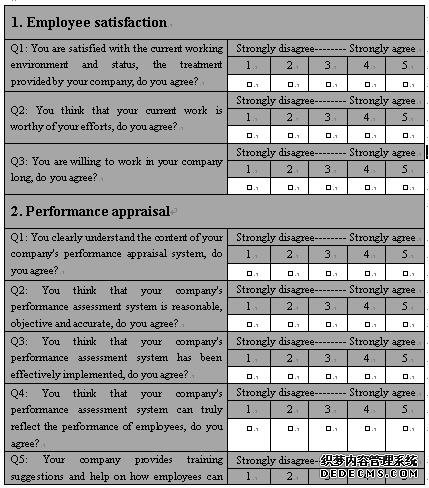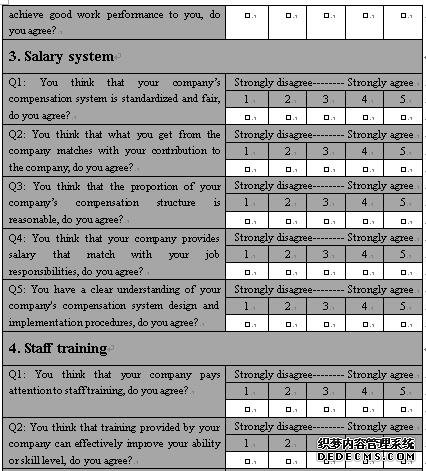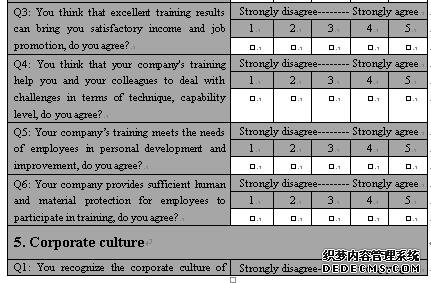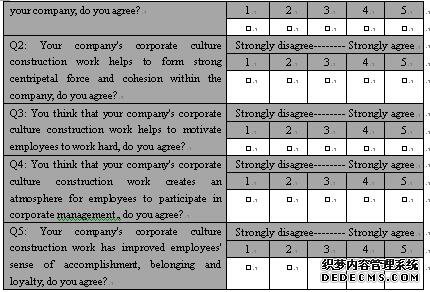|
1.0 Introduction介绍
1.1 Background背景
中国是一个巨大的制造国。其成功的原因之一是其数亿愿意服从管理的熟练工人和低工资制造业员工(Chin和Rowley,2018年)。然而,自2015年以来,中国制造业出现了员工招聘不足的现象,企业甚至连愿意提供三倍工资的合适人选都找不到,这给中国制造业带来了极大的挑战。CTuring公司(张、万、王,2017年)。一是劳动力成本大幅度增加,消耗了企业原有利润不高的部分。第二,企业必须降低对工人的标准,使一些不合格工人进入企业,导致生产效率和产品质量可能出现问题(_ech等人,2016)。对于中国制造企业来说,如何留住员工,让他们愿意在公司里长期积极工作,是一项具有挑战性和重要意义的任务。
China is a huge manufacture country. One of the reasons for its success is its hundreds of millions of skilled workers who are willing to obey the management, and low-wage manufacturing employees (Chin and Rowley, 2018). However, since 2015, there has been a phenomenon of insufficient recruitment of employees in China's manufacturing industry, and the companies have even failed to find enough suitable people even they were willing to offer triple wages, such problems have brought extreme challenge to Chinese manufacturing companies (Zhang, Wan and Wang, 2017). First, the cost of labor has been greatly increased, which has consumed the enterprises’ profits which were not high original. Second, the enterprises have to reduce the standards for workers, making some unqualified workers enter the companies, resulting in possible problems in production efficiency and product quality (Čech et al., 2016). For Chinese manufacturing companies, how to retain employees and make them willing to work actively in the companies for a long time is a challenging and important task.
1.2 Motivation动机
为了使员工能够长期积极地为公司工作,提高员工的满意度是非常重要的。大量研究表明,高满意度的员工更热情、更专注,能够为客户提供更好、更优质的服务,这实际上为公司带来了更大的回报(Milliman,Gatling&Kim,2018;Lacy,2018;Alegre,Mas MachuCA和Berbegal Mirabent,2016年)。但是,如果员工的满意度较低,他们没有工作的热情或动机,他们的消极情绪也会影响到客户,从而影响公司的业绩,并导致公司遭受损失(Lacy,2018;Alegre,Mas Machuca和Berbegal Mirabent,2016)。提高工人的工资和福利是提高员工满意度的一个好途径。然而,大量的研究表明,工资激励显示出边际递减效应。当达到一定水平时,提高工资不仅不能提高员工的满意度,而且会增加企业成本,使员工更加松懈(张、万、王,2017),这就是为什么中国企业将工资提高了三倍,仍然找不到合适的员工的原因。锿。因此,对于中国企业来说,如何采取全面的措施来提高员工满意度是一个亟待解决的问题。
To make employees willing to work actively for a company for a long time, it is very important to pay attention to improving employee satisfaction. A large number of studies have shown that employees with high satisfaction are more enthusiastic and committed, and they can provide customers with better and higher quality services, which virtually brings greater returns to the company (Milliman, Gatling & Kim, 2018; Lacy, 2018; Alegre, Mas-Machuca and Berbegal-Mirabent, 2016). However, if employees have low satisfaction, they do not have a passion or motivation to work, their negative emotions will also affect their customers, thus affecting the company's performance and causing the company to suffer losses (Lacy, 2018; Alegre, Mas-Machuca and Berbegal-Mirabent, 2016). Raising the wages and benefits of workers is a good way to improve employee satisfaction. However, a large number of studies have shown that wage incentives show a marginal diminishing effect. When a certain level is reached, raising wages will not only fail to improve employee satisfaction, but also increase corporate costs and make employees more slack (Zhang, Wan and Wang, 2017), which is why Chinese companies have increased their wages threefold and still cannot find suitable employees. Therefore, for Chinese companies, how to adopt comprehensive measures to improve employee satisfaction is an issue they urgently need to solve.
Founded in 1974, Foxconn Technology Group is a leading global OEM company specializing in computers, communications, consumer electronics, digital content, automotive components, and access roads (Enderwick and Buckley, 2017). It has more than one million employees, the success of Foxconn is closely related to its own strict and effective employee management. However, after entering 2010, more and more employees of Foxconn are young people of post-1990 generation. Compared with their predecessors, they are more aware of their personalities and rights, but they are also weak in terms of hard work. Therefore, Foxconn’s past strict management models and methods that proved to be effective are not as effective for post-1990 employees and it has negatively impacted on the employees. For example, since January 23, 2010, it has seen 14 suicides in Foxconn, which has aroused concern from all walks of life and even the world (Christos, 2015). Frequent suicide events indicate that the current level of employee satisfaction of Foxconn s is relatively low, and the low employee satisfaction not only affects corporate management, work efficiency and income, but also has a negative impact on corporate image. Foxconn, as the best manufacturing company in China, has a low degree of employee satisfaction. It can be imagined that the average employee satisfaction rate in China's current manufacturing industry may be lower. The manufacturing industry plays a major role in the steady development of the Chinese economy. Therefore, it is of great practical significance to study how to improve the employee satisfaction of Chinese manufacturing industry.
1.3 Aims and objectives
The research aim of this paper is to understand the employee satisfaction in Chinese manufacturing companies, and what the factors affecting the employee satisfaction? Based on the research aim of this article and the literatures from Čech et al. (2016), Zhang, Wan and Wang (2017), Chin and Rowley (2018), the following research objectives were formed:
Research objective 1: To understand the impact of performance appraisal system on the employee satisfaction in China's manufacturing industry;
Research objective 2: To understand the impact of compensation management system on the employee satisfaction in China's manufacturing industry;
Research objective 3: To understand the impact of staff training on the employee satisfaction in China's manufacturing industry;
Research objective 4: To understand the impact of corporate culture on the employee satisfaction in China's manufacturing industry;
Research objective 5: To recommend on improving the employee satisfaction for Chinese manufacturing enterprises.
1.4 Research question
Research question 1: What are the characteristics of the current performance appraisal system of Chinese manufacturing companies? What are the deficiencies of the current performance appraisal system for improving employee satisfaction, and what improvements it should make to better improve employee satisfaction?
Research question 2: What are the characteristics of the current compensation management system in Chinese manufacturing companies? What are the shortcomings of the current salary management system for improving employee satisfaction? What improvements should be made in current compensation management to better improve employee satisfaction?
Research question 3: What are the characteristics of the current staff training in Chinese manufacturing companies? What are the deficiencies of the current employee training system in improving employee satisfaction? What improvements the current employee training system should make to better improve employee satisfaction?
Research question 4: What are the characteristics of the current corporate culture of Chinese manufacturing companies? What are the shortcomings of the current corporate culture for improving employee satisfaction? What changes the current corporate culture should make to better improve employee satisfaction?
2.0 Methodology
2.1 Introduction
In the following sections, it introduces the methodology of this article, including the research philosophy, research methods, data collection methods, analysis methods, and so on.
2.2 Epistemology and methodology
2.2.1 Epistemology
Epistemology is a philosophical theory that discusses the nature of human cognition, the relationship between cognition and objective reality, and the truth standards of cognition (Hull, 2015). Epistemological disputes mainly focus on two extremes: positivism and anti-positivism, anti-positivism is divided into various schools, of which interpretivism is one of the most important theoretical schools (Loison, 2016).
Positivism believes that the world is real and can be observed, if people want to understand the world, they must obtain various data through observation, there are mainly quantified data, through scientific, objective, and value-neutral dealing with the data to gain an understanding of the world; people's results of this recognition can be confirmed by new cases, and the knowledge of the new case will be preserved as a credible objective law; human society has the same objective rules as the natural world (Outhwaite, 2015). Human society can also be recognized through scientific methods, and it can form general laws with universal applicability (Keuth, 2015).#p#分页标题#e#
Interpretivism holds that the world is the result of subjective construction of people; since the world is the result of people's construction, there is no objective law, and the most important thing is to understand why people constructs it like that (Packard, 2017). Since the world is constructed, then the world is different. Therefore, people should not summarize what the universal law is. Instead, they should understand the difference in the world and the hidden meaning behind it (Chapman, 2018).
The purpose of this study is to understand the overall satisfaction of Chinese manufacturing employees and to analyze the general factors and laws that affect their satisfaction. Therefore, this article is more applicable to positivist epistemology. This paper is not a study of the satisfaction of a company's employees, and it is not an analysis of the specific factors that affect the company's employees' satisfaction. Therefore, interpretive epistemology is not suitable for this study.
2.2.2 Methodology
Methodology refers to the ways that people use to understand the world. In general, methodology is divided into two major types: one is objectivist methodology, and the other is constructivist methodology (Saunders, Lewis and Thornhill, 2007). The objectivist methodology holds that knowledge is an objective and existing truth. Researchers can discover and understand the objective knowledge and discover universal laws through certain research methods such as quantitative research methods (Herring, 2018).
Epistemology has an important influence on the choice of methodology. Positivists often use objective methodology to understand the world, while those who hold interpretive epistemology often use constructivist methodology to understand the world (Loison, 2016). This article is based on the positivist epistemology, so the methodology of this article is the objectivist methodology. In addition, the research aim of this paper is to understand the satisfaction of the overall manufacturing employees in China, and to analyze and discover the general factors and laws that affect their satisfaction. From the perspective of the research aim of this study, the use of objectivist methodology is also appropriate.
2.3 Research approach
2.3.1 Quantitative research
Quantitative research refers to the research methods that quantify problems and phenomena, by analyzing, testing and interpreting them to obtain the law of change in quantity (Saunders, Lewis and Thornhill, 2007). This paper will collect data to understand the satisfaction of Chinese manufacturing employees and uses quantitative data analysis to understand which factors are statistically significant factors that affect their satisfaction.
Generally, quantitative analysis data includes first-hand data and second-hand data. First-hand data is data collected by a researcher himself through questionnaires, observation methods, experiments, etc. Advantages of first-hand data lie in the relatively high correlation, timeliness and reliability, but the disadvantage is that first-hand data collection takes a lot of time and money, and because the research objects of this survey is the Chinese manufacturing employees, the total number of these employees is more than 100 million, and only depending on the first-hand data collected by the author cannot reflect their job satisfaction truly, effectively and comprehensively. Therefore, this paper will not collect first-hand data but collect second-hand data to complete the quantitative research. It is estimated that about 200 sets of second-hand data will be collected.
Second-hand data is relative to the original data and refers to statistics that have not been collected for this study but have been collected for other purposes. Compared with the original data, the second-hand data has the advantages of rapidity, low cost, easy access, and so on. Disadvantages of second-hand data are reflected in three aspects: poor correlation, poor timeliness, and low reliability. In order to solve these inadequacies of second-hand data, the author will start the collection of second-hand data from the following aspects based on the recommendations from Creswell (2003), Saunders, Lewis and Thornhill, (2007). First of all, considering from research aim, each study has a specific aim. Before collecting second-hand data, it must know why the data should be collected for the study. The more consistent the research aim is with this study, the more the correlation of the data will be. Secondly, judging from the content of research, the contents of research mainly include: research questions, key variables, overall research, measurement units, and basic conclusions. Judging whether these data are useful information currently needed is an important aspect of correlation assessment. Thirdly, about research methods, investigation on research methods is the main basis for the reliability of data. Fourthly, about the source of information, after convincing that the research aim is not biased, the data user should also consider the reputation and competitiveness of the organizations that collect the data. Finally, in terms of data collection time, second-hand data is the data that have existed prior to the current study, so these data have outdated problems to varying degrees. The newer the collected data are, the stronger the timeliness is.
2.3.2 Qualitative research
Qualitative researchers use historical review, literature analysis, interviews, observations, participation experiences, and other methods to obtain data in a natural context, and use non-quantitative means to analyze it and obtain research conclusions (Creswell, 2003). Qualitative research places more emphasis on significance, experience, and description (Saunders, Lewis and Thornhill, 2007). Specifically, the qualitative research method used in this paper is mainly literature research method, that is, through the review of the relevant literatures to understand the related theory of employee satisfaction to complete the construction of the theoretical basis of this research, and from the relevant empirical research, it will find the information needed in this paper for the analysis of the second-hand data collected in this paper. Advantages of the literature analysis method lie in that the analysis costs less time and money and it has high work efficiency; it can provide basic information and information for further analysis. The disadvantage is that the information collected may not comprehensive enough, or the information collected is not authoritative. In order to get comprehensive information, the author has collected more than 40 pieces of studies on the satisfaction of manufacturing employees at home and abroad to ensure that the information acquired is comprehensive. At the same time, the information collected by the author comes from government reports, authoritative magazines and databases to ensure the authority of information.
2.4 Data collection
The data collected in this paper will mainly include the impact on employee satisfaction from four aspects: performance appraisal, salary management, employee training, and corporate culture. The objects of this survey will be the Chinese manufacturing employees. All the data comes from the research on Chinese manufacturing employees.
The data for measuring employee satisfaction is mainly determined based on researches from Milliman, Gatling and Kim (2018), Lacy (2018), Alegre, Mas-Machuca and Berbegal-Mirabent (2016), including: to what extent the employees are satisfied with their current working environment and status, as well as salary; to what extent they think that the current work deserves their own hard work; to what extent they are willing to work long-term in their companies, and so on.
The data used to measure employee satisfaction with performance appraisal is mainly determined based on researches from Kang and Busser (2018), Alegre, Mas-Machuca and Berbegal-Mirabent (2016), Jacobs, Yu and Chavez (2016), including to what extent the employees believe that the performance appraisal system of their company is fair and reasonable; to what extent they believe that the performance assessments can accurately reflect their job performance; to what extent the results of performance appraisal have an impact on their income; to what extent they think that the performance assessment system has been effectively implemented, and so on.
Data used to measure employee satisfaction with salary management will mainly be determined based on Navimipour and Zareie’s (2015), Alegre, Mas-Machuca and Berbegal-Mirabent’s (2016), Hatane’s (2015) research, including to what extent the employees think that their compensation system is normative and fair; o what extent they think that what they acquire matches what they contribute to their company; to what extent they think that their compensation structure is reasonable; to what extent they clearly understand the design and implementation procedures of their compensation system, and so on.
The data used to measure employee satisfaction with staff training will mainly be determined based on Lacy’s (2018), Milliman, Gatling and Kim’s (2018), Cheng and Yang’s (2018) researches, including to what extent the employees think that their company values employee training; to what extent they think that the company's training can effectively improve their ability or skill; to what extent they think that excellent training results can bring them satisfactory income and job promotion; to what extent they think that their company has provided adequate human and material protection for employees to participate in training, and so on.
The data used to measure employee satisfaction with corporate culture is mainly determined based on Navimipour and Zareie’s (2015), Cheng and Yang’s (2018), Alegre, Mas-Machuca and Berbegal-Mirabent’s (2016) researches, including to what extent the employees think that the company's corporate culture is conducive to the formation of strong centripetal force and cohesion within the company; to what extent they think that the company's corporate culture can motivate employees to work hard; to what extent they think that the company’s corporate culture has improved employees’ sense of accomplishment, sense of belonging and loyalty; to what extent they think that the company’s corporate culture has created an atmosphere for employees to participate in business management, and so on.#p#分页标题#e#
All data collected will be recorded in the form of Likert scale. From 1 to 5, it represents from “strongly disagree” to “strongly agree”. If the second-hand data collected are not originally recorded in the form, these data will be converted into the form.
Table 1 Evaluation standard of descriptive statistics (Best, 1997)
3.0 Data analysis
The data analysis tool will be SPSS 22.0. Data analysis is mainly divided into three steps. First, the reliability and validity of the data will be analyzed. The author will use α reliability coefficient method to analyze the reliability of the data. If Cronbach's α coefficient is greater than 0.7, indicating that the reliability is acceptable. The author will use factor analysis to test the validity, if the kmo value is greater than 0.5, P value is less than 0.05, and the Bartlett test shows P <0.01, indicating that the data structure is valid. Then, the descriptive statistics of the survey results will be included, including the mean, standard deviation, frequency, etc., and the data will be analyzed according to the Best (1997) standard to see if the interviewee's evaluation is high or low. The third step is the correlation analysis, it understand the correlation coefficient between employee satisfaction and performance appraisal, salary management, staff training, and corporate culture.
Qualitative data analysis mainly adopts the Analysis Hierarchy Process (AHP), which analyzes the impact on employees' satisfaction from four aspects: performance appraisal, salary management, employee training, and corporate culture, and compares whether the quantitative analysis results of this article are in line with the qualitative analysis results. If it is inconsistent, further analysis will be made.
4.0 Research time plan
The schedule of this study is shown as follows.
Table 2 Time schedule
Figure 1 Gantt chart of time progress
5.0 Research ethics
The author will save all data and information used in this research, and they will be stored in the author’s email box, without permission, no one can visit the email box to get the original data and information to lead to any information leak.
All data will be used only in this research and they will not be used for some commercial purposes. The author will personally deal with the collection and analysis of all the data in this study to ensure that all the second-hand data obtained are true and reliable. In data analysis and transcribing, the author will check again to ensure that there will be no deviation.
References
Alegre, I., Mas-Machuca, M., & Berbegal-Mirabent, J. (2016). Antecedents of employee job satisfaction: Do they matter? Journal of Business Research, 69(4), 1390-1395.
Best, J.W. (1997). Research in education. 3rd ed. Englewood Cliff, NJ: Prentice Hall, Inc.
Čech, M., Yao, W., Samolejová, A., Li, J., & Wicher, P. (2016). Human Resource Management in Chinese manufacturing companies. Perspectives in Science, 7(3), 6-9.
Chapman, C. S. (2018). Interpretive methodological expertise and editorial board composition. Critical Perspectives on Accounting, 51(3), 47-51.
Cheng, J., &Yang, Y. O. (2018). Hotel employee job crafting, burnout, and satisfaction: The moderating role of perceived organizational support. International Journal of Hospitality Management, 72(6),78-85.
Chin, T. and Rowley, C. (2018). Chapter two: challenges for manufacturing in China. The Future of Chinese Manufacturing, 5-24.
Creswell, J. (2003). Research design: qualitative, quantitative, and mixed methods approaches. London: International Educational and Professional Publisher.
Christos, K. (2015). Foxconnian culture: an operational crisis abetted suicides. Procedia - Social and Behavioral Sciences, 175(12), 447-454.
Enderwick, P. and Buckley, P. J. (2017). Beyond supply and assembly relations: Collaborative innovation in global factory systems. Journal of Business Research,12 (9), 102-114.
Hatane, S. E. (2015). Employee Satisfaction and Performance as Intervening Variables of Learning Organization on Financial Performance. Procedia - Social and Behavioral Sciences, 211(25), 619-628.
Herring, J. E. (2018). Chapter 9: Constructivist grounded theory: A 21st century research methodology. Research Methods (Second Edition), 225-240.
Hull, D. L. (2015). Evolutionary epistemology. International Encyclopedia of the Social & Behavioral Sciences, 437-440.
Jacobs, M. A., Yu, W., & Chavez, R. (2016). The effect of internal communication and employee satisfaction on supply chain integration. International Journal of Production Economics, 171(1), 60-70.
Kang, H. J., & Busser, J. A. (2018). Impact of service climate and psychological capital on employee engagement: The role of organizational hierarchy. International Journal of Hospitality Management, 75(9), 1-9.
Keuth, H. (2015). Logical positivism and logical empiricism. International Encyclopedia of the Social & Behavioral Sciences, 313-318.
Lacy, R. A. (2018). From spirituality to strategies: a chaplain's guide to improve employee satisfaction and workplace positivity. Nurse Leader, 16(3),173-176.
Loison, L. (2016). Forms of presentism in the history of science. Rethinking the project of historical epistemology. Studies in History and Philosophy of Science Part A, 60(12), 29-37.
Milliman, J., Gatling, A., & Kim, J. S. (2018). The effect of workplace spirituality on hospitality employee engagement, intention to stay, and service delivery. Journal of Hospitality and Tourism Management, 35(6), 56-65.
Navimipour, N. J., & Zareie, B. (2015). A model for assessing the impact of e-learning systems on employees’ satisfaction. Computers in Human Behavior, 53(12), 475-485.
Outhwaite, R. W. (2015). Positivism, wociological. International Encyclopedia of the Social & Behavioral Sciences (Second Edition), 625-629.
Packard, M. D. (2017). Where did interpretivism go in the theory of entrepreneurship? Journal of Business Venturing, 32(5), 536-549.
Saunders, M., Lewis, P. and Thornhill, A. (2007). Research methods for business students (4th, ed.).Essex, Pearson Education Limited.
Zhang, X., Wan, G. and Wang, X. (2017). Road infrastructure and the share of labor income: Evidence from China’s manufacturing sector. Economic Systems, 41(4), 513-523.
Appendix I Questionnaire
Dear participant!
We are implementing a study on “An employee satisfaction survey in manufacturing industry: A case of Foxconn”. Therefore, we will greatly appreciate if you can finish the following questionnaire which may take you about 10 minutes.
Your participations subject to privacy policies and will be handled anonymously. We sincerely thank you for your collaboration!
Part I: In the following questions, five degrees are used to reflect your answers to each question, please tick the option that can reflect your true opinion most.
    |
 |
|||
| 网站地图 |

